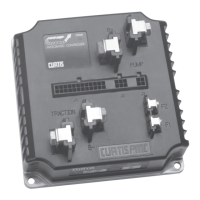Curtis PMC 1297 Manual
51
Most applications use a throttle to provide variable speed control of Lift and Lower.
A throttle gives the operator more flexibility and control over performance than is
provided by the Lift and Lower switches alone. Without a throttle, when the Lift
switch is closed, the pump accelerates to the set maximum pump speed in the set pump
acceleration time; when the Lower switch is closed, the lowering valve current ramps
from 0% to 100% in the set LV acceleration time. For variable speed control, a
throttle is required.
The hydraulic throttle is wired in parallel with the main traction throttle, as
shown in the diagrams in the throttle wiring section (Section 2).
HYD THRTL TYPE
The 1297 controller accepts a variety of hydraulic throttle inputs. Instructions
are provided in Section 2 for wiring the most commonly used throttles: 3-wire
pots (single-ended or wigwag), 0–5V throttles (single-ended or wigwag), cur-
rent sources (single-ended or wigwag), and the Curtis ET-XXX electronic
throttle.
The hydraulic throttle type parameter can be programmed to 2 or 4. The
standard throttle input signal type options are listed in Table 4.
Table 4 PROGRAMMABLE THROTTLE TYPES:
Hydraulic Throttle
THROTTLE
TYPE DESCRIPTION
2 single-ended 3-wire potentiometer with 1kΩ to 10kΩ range;
0–5V voltage source; current source;
or Curtis ET-1XX electronic throttle
4 wigwag 3-wire potentiometer with 1kΩ to 10kΩ range;
0–5V voltage source; or current source
HYD THRTL DB
The hydraulic throttle deadband parameter defines the pot wiper voltage
range the controller interprets as neutral. Increasing the throttle deadband
setting increases the neutral range. This parameter is especially useful with
throttle assemblies that do not reliably return to a well-defined neutral point,
because it allows the deadband to be defined wide enough to ensure that the
controller goes into neutral when the throttle mechanism is released.
Examples of deadband settings (40%, 10%, 0%) are shown in Figure 21
for throttle types 2 and 4.
Hydraulic Throttle Parameters
3
B
— PROGRAMMABLE HYDRAULIC PARAMETERS: Hydraulic Throttle

